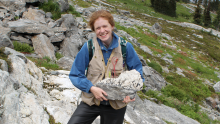Canada needs a bold vision to fully understand its biodiversity resources.
This is a central finding of a group of 14 eminent experts, including two UBC scientists, brought together by the Council of Canadian Academies.
UBC professors Wayne Maddison and Sarah Otto were part of an expert panel that was charged with assessing the state and trends of taxonomy--the science that discovers, distinguishes, classifies and documents living things--in Canada. The report, released today, observes that failure to understand Canadian biodiversity could have significant consequences for ecosystems, the economy, innovation potential and society.
“Our report examined three key areas,” said Dr. Thomas Lovejoy, chair of the expert panel. “Canada’s taxonomic expertise; the state of biodiversity collections; and access to data about Canadian biodiversity. After assessing the evidence in each of these areas we concluded that Canada is not yet equipped to fully understand the challenges of its biodiversity resources.”
“Taxonomists are critical for identifying and protecting species at risk,” said Otto. “We can only protect that which we know about and we only know a small fraction of the species on earth.”
“It’s been estimated there are five to ten million species on earth and we only have records of about 1.6 million of these species. Their extinction rate is dramatically higher than historical records. Current estimates state that species are going extinct 1000 times faster than they have in the past.”
The first step to protecting biodiversity is ensuring the expertise is in place to address environmental challenges such as invasive species, according to the panel. In recent years, species such as zebra mussels, and the emerald ash borer, have cost North Americans billions of dollars.
“If we don’t have taxonomists in place, then we either fail to identify invasive species or identify them too late to properly tackle them,” said Otto. “This happened to us in Canada with the brown spruce longhorn beetle.”
Strong taxonomic capacity is essential for intercepting and eradicating these species before they establish themselves. Moreover, taxonomic research contributes to economic development in the renewable resource sector and the emergent field of bioproducts.
Evidence suggests that training and job opportunities are limited and research funding has stagnated. As a result, there has been a decline in Canada’s international contribution to new species descriptions, falling from 6th in the 1980s to 14th in the 2000s. The panel also observed that although Canada has impressive biodiversity collections and a strong digital infrastructure, most information is trapped in cabinets rather than being accessible on the internet. As a result, Canada’s data sharing efforts compare poorly internationally. Approximately 80 per cent of Canada’s online biodiversity information is being held outside Canada.
Within Canada, collections house over 50 million specimens, conservatively valued at over a quarter of a billion dollars. However, inadequate curatorial capacity, aging facilities and the lack of a national strategy or standards, have placed Canada at risk of losing long-term information essential to understanding changes in biodiversity. This information is critical for making informed policy and management decisions.
Maddison--Canada Research Chair in Biodiversity and Director of UBC's Beaty Biodiversity Museum--studies spider biodiversity and the use of phylogeny in evolutionary inference. Otto investigates population genetics and evolutionary biology, developing and analyzing mathematical models to study how populations change over time.
For more information, please visit www.scienceadvice.ca/biodiversity.
About the Council of Canadian Academies
The Council of Canadian Academies is an independent, not-for-profit corporation that began operation in 2005. The Council supports evidence-based, expert assessments (studies) to inform public policy development in Canada. Assessments are conducted by independent, multidisciplinary panels of experts from across Canada and abroad. The Council’s blue-ribbon panels serve free of charge and many are Fellows of the Council’s Member Academies: the RSC: The Academies of Arts, Humanities and Sciences of Canada; the Canadian Academy of Engineering; and the Canadian Academy of Health Sciences. The Council’s reports are published and made available to the public free of charge. For information please visit the Council’s website at www.scienceadvice.ca.


